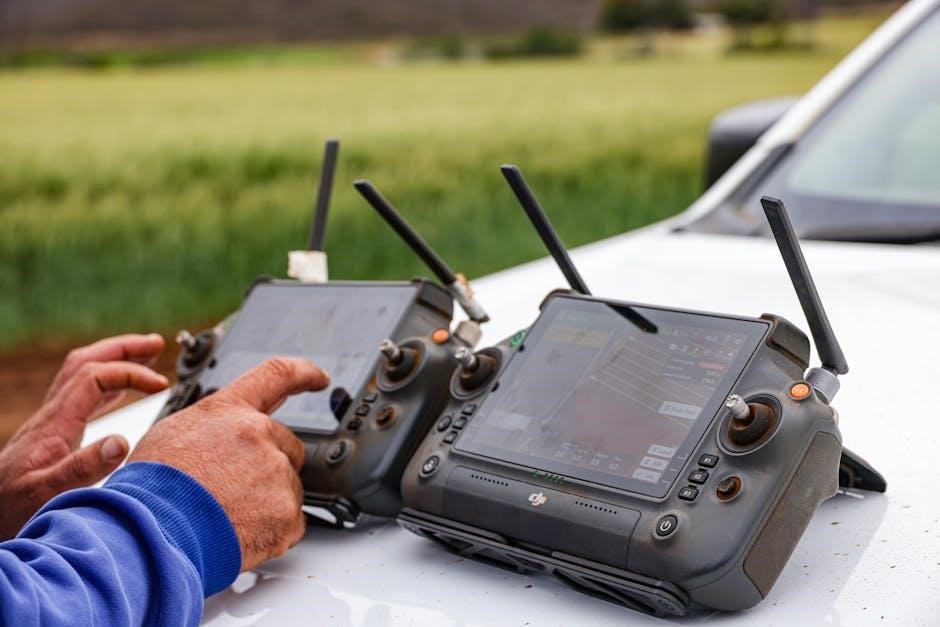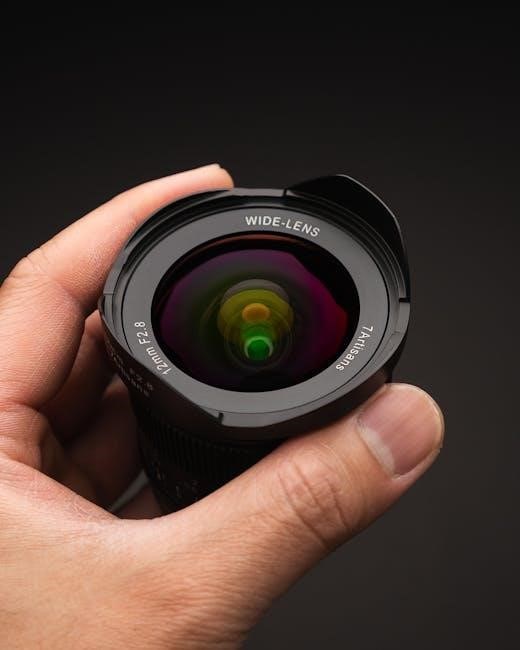pir sensor with manual override
PIR sensors with manual override detect infrared radiation from moving objects, triggering responses like lighting. The override feature allows switching between automated and constant operation, enhancing flexibility in security and energy efficiency.
1.1 Definition and Basic Functionality
A PIR (Passive Infrared) sensor with manual override is an electronic device detecting infrared radiation emitted by objects within its field of view. It triggers responses, such as activating lights or alarms, when motion is detected. The manual override feature allows users to switch between automated sensor mode and constant operation, providing flexibility in security and energy management. This dual functionality enhances convenience and efficiency, making it ideal for various applications like security lighting and smart home systems. The sensor’s ability to detect heat energy ensures reliable motion detection while the override offers user control when needed.
1.2 Importance of Manual Override in PIR Sensors
The manual override feature in PIR sensors is crucial for adding flexibility and control to automated systems. It allows users to disable the sensor’s automatic detection temporarily, preventing false triggers during specific events or maintenance. This feature ensures uninterrupted operation in scenarios where motion detection is not desired, enhancing overall system reliability. Additionally, it provides a backup option for continuous operation, ensuring safety and convenience. The manual override capability makes PIR sensors more versatile, catering to diverse user needs and environments while maintaining energy efficiency and performance.

How PIR Sensors with Manual Override Work
PIR sensors with manual override detect infrared changes to trigger responses. The manual feature allows disabling the sensor for uninterrupted operation, ensuring flexibility in various settings.
2.1 Operating Principles of PIR Sensors
PIR sensors detect motion by monitoring infrared radiation changes. They use pyroelectric elements to sense temperature variations when objects enter their field. A lens focuses IR onto the detector, maximizing coverage. The sensor triggers an electrical signal when motion is detected, processed by circuitry to amplify and filter noise. This ensures accurate detection, minimizing false triggers. The output is sent to a control unit, activating lights or alarms. The manual override integrates seamlessly, allowing users to disable detection temporarily without affecting core functionality.
2.2 Mechanism of Manual Override Function
The manual override function in PIR sensors provides users with direct control over the system. It typically involves a physical switch or digital interface that bypasses the automatic detection mode. When activated, the sensor ignores motion signals, allowing continuous operation of connected devices like lights or alarms. This feature is useful for scenarios requiring uninterrupted functionality. The override mechanism is designed to seamlessly integrate with the sensor’s circuitry, ensuring reliable switching between automatic and manual modes without compromising performance or security.
Applications of PIR Sensors with Manual Override
PIR sensors with manual override are widely used in security systems, smart lighting, and automation. They enhance control over motion detection in various residential and commercial settings.
3.1 Security Lighting Systems
PIR sensors with manual override are extensively integrated into security lighting systems to enhance safety and convenience. These sensors detect motion and automatically activate lights, deterring intruders and improving visibility. The manual override feature allows users to switch the lights on or off independently, providing flexibility in situations where automated detection is not desired. This dual functionality ensures reliable security coverage while offering personalized control, making them ideal for both residential and commercial security applications. The combination of automation and manual operation ensures optimal performance in various lighting scenarios.
3.2 Home Automation and Smart Lighting
PIR sensors with manual override play a significant role in home automation and smart lighting systems by offering seamless control and energy efficiency. These sensors integrate with smart home systems, enabling automatic lighting adjustments based on occupancy. The manual override feature allows users to bypass automation, providing flexibility in lighting preferences. This integration enhances convenience, as lights can be controlled remotely or through voice commands, creating a personalized and efficient living environment. The combination of automation and manual control ensures a balance between smart functionality and user preference, making it ideal for modern smart homes.

Design and Components of PIR Sensors
PIR sensors with manual override consist of a pyroelectric sensor, infrared lens, and circuitry. The manual override feature adds a switch for bypassing automatic detection, enhancing user control.
4.1 Key Components of PIR Sensors
PIR sensors with manual override include a pyroelectric sensor, infrared lens, and circuit board. The pyroelectric sensor detects temperature changes, while the lens focuses infrared radiation. The circuit board processes signals and manages the override function. Additional components may include a manual switch for disabling automatic detection and a housing unit for environmental protection. These elements work together to enable accurate motion detection and user-controlled operation, ensuring reliability and flexibility in various applications.
4.2 Integrated Circuit and Sensitivity Detector
The integrated circuit in PIR sensors processes signals from the pyroelectric sensor, amplifying and filtering them to detect motion accurately. The sensitivity detector adjusts the sensor’s responsiveness, ensuring it triggers only for significant movements. Together, these components enhance reliability and reduce false alarms. The manual override feature is integrated into the circuit, allowing users to disable automatic detection temporarily. This combination of advanced electronics and adjustable sensitivity ensures precise control and flexibility in various applications, making PIR sensors versatile for security and automation systems.

Performance Factors of PIR Sensors
PIR sensor performance depends on coverage area, sensitivity, response time, and detection range. These factors ensure reliable motion detection, optimizing effectiveness in various applications like security and automation.
5.1 Coverage Area and Sensitivity
PIR sensors with manual override typically cover a range of 10 to 30 feet, depending on the model and installation height. Sensitivity adjustments allow customization to minimize false triggers, ensuring accurate motion detection. The coverage area can be tailored using lens filters or adjustable settings, while sensitivity tuning helps adapt to environmental conditions. This balance ensures reliable performance in various applications, from security systems to smart lighting, enhancing overall efficiency and user satisfaction with precise detection capabilities.
5.2 Response Time and Detection Range
PIR sensors with manual override typically have a response time of less than a second, ensuring quick detection of motion. The detection range varies between 10 to 30 feet, depending on the sensor model and installation height. Environmental factors like temperature fluctuations can affect response time, while physical obstructions may reduce the effective detection range. Adjusting sensitivity can optimize both, balancing quick reactions with accurate motion sensing. This ensures reliable performance in security systems and smart lighting, where timely and precise detection is crucial for functionality and user satisfaction.

Installation and Setup of PIR Sensors
PIR sensors require careful installation, typically mounted at 2-3 meters high for optimal coverage. Adjust the sensor angle and ensure proper wiring connections. Follow manufacturer guidelines for setup and test functionality post-installation.
6.1 Placement and Mounting Considerations
Proper placement is critical for optimal performance. Mount PIR sensors at a height of 2-3 meters to ensure coverage of the desired area. Ensure the sensor’s field of view is unobstructed by furniture or vegetation. Positioning should avoid direct sunlight or heat sources to prevent false triggers. The sensor’s angle can be adjusted to customize detection zones. For manual override functionality, ensure easy access to the switch. Consider the environment, such as temperature extremes or humidity, which may affect performance. Secure mounting prevents vibration or movement that could compromise accuracy.
6.2 Wiring and Power Supply Requirements
PIR sensors with manual override typically require a stable DC power supply, commonly between 12-24 volts. Proper wiring ensures reliable operation; use appropriately gauged wires to minimize voltage drop. Grounding is essential to reduce interference. Connect the sensor’s terminals correctly, following the manufacturer’s wiring diagram. Install a backup power source, like a battery, for uninterrupted function during outages. Ensure all connections are secure and insulated to prevent short circuits. Always disconnect power before wiring to avoid electrical shock. Adhere to local electrical codes and manufacturer guidelines for optimal performance and safety.

Troubleshooting Common Issues
Identify common issues like false triggering, delayed response, or sensor malfunction. Check wiring connections, adjust sensitivity settings, and ensure proper power supply. Clean the sensor and reset it if necessary.
7.1 Common Problems with PIR Sensors
PIR sensors with manual override may face issues like false triggering, delayed response, or malfunction after manual activation. These problems often arise from improper installation, sensitivity settings, or environmental interference. Dust, dirt, or direct sunlight can obstruct the sensor’s field of view. Additionally, wiring faults or power supply inconsistencies may cause erratic behavior. Addressing these issues requires cleaning the sensor, adjusting settings, and ensuring proper installation. Regular maintenance and troubleshooting can prevent such problems and ensure reliable performance.
7.2 Resetting and Calibrating the Sensor
Resetting and calibrating a PIR sensor with manual override ensures optimal performance and accuracy. Start by turning off the power supply and waiting for the sensor to reset. Use the manual override feature to test the sensor’s response. Adjust sensitivity settings to minimize false triggers. Calibration may involve setting time delays and detection ranges. Consult the manufacturer’s instructions for specific steps. Regular recalibration helps maintain reliability, especially after manual overrides or environmental changes. Proper calibration ensures the sensor detects motion accurately while ignoring unwanted signals.

Security and Privacy Concerns
PIR sensors with manual override raise privacy concerns due to motion tracking. Unauthorized access to the override feature can compromise security. Ensure data protection and secure installations.
8.1 Data Protection in PIR Systems
PIR systems with manual override must prioritize data protection to prevent unauthorized access. Encrypting sensor data and ensuring secure communication protocols, such as SSL/TLS, safeguard information transmission. Manufacturers often implement data anonymization to protect user privacy. Regular software updates and secure authentication methods further enhance system security. Physical protection of sensors and restricted access to override features minimize tampering risks. Compliance with data protection regulations ensures ethical use and user trust in PIR systems.
8.2 Ethical Considerations in Surveillance
Using PIR sensors with manual override raises ethical concerns, particularly regarding privacy and consent. Surveillance systems must balance security needs with individual privacy rights. Clear guidelines and transparency about data collection and usage are essential. Ensuring informed consent from individuals under surveillance is crucial. Additionally, systems should avoid disproportionate monitoring and respect personal boundaries. Ethical deployment involves regular audits and accountability measures to prevent misuse. Compliance with privacy laws, such as GDPR, further ensures responsible use of PIR technologies in surveillance applications.

Energy Efficiency and Power Consumption
PIR sensors with manual override are designed for low power consumption, ensuring energy efficiency. They use advanced circuitry to minimize energy use while maintaining functionality, reducing operational costs and environmental impact.
9.1 Low Power Modes and Energy Saving Features
PIR sensors with manual override often include low power modes to reduce energy consumption. These modes deactivate non-essential functions when the sensor is idle, minimizing battery drain. Energy-saving features like adjustable sensitivity and delay timers optimize performance while lowering power use. Some models incorporate sleep modes, waking only when motion is detected. Additionally, manual override allows users to disable the sensor temporarily, further conserving energy. These features ensure the sensor operates efficiently, extending battery life and reducing overall power consumption without compromising functionality or reliability.
9.2 Eco-Friendly Aspects of PIR Sensors
PIR sensors with manual override contribute to eco-friendliness by minimizing energy consumption and reducing the need for frequent replacements. Their motion-detection technology ensures that connected devices, like lights, operate only when necessary, lowering overall power usage. Many models use recyclable materials and have long lifespans, reducing electronic waste. Additionally, the manual override feature allows users to deactivate the sensor when not needed, further conserving energy and promoting sustainability. These eco-friendly attributes make PIR sensors a responsible choice for modern applications, aligning with environmental conservation goals.

Integration with Smart Home Systems
PIR sensors with manual override seamlessly integrate with smart home systems, enabling voice control, remote access, and compatibility with platforms like Zigbee and Z-Wave for enhanced automation and flexibility.
10.1 Compatibility with IoT Devices
PIR sensors with manual override are highly compatible with IoT devices, enabling seamless integration into smart home ecosystems. They can connect to Wi-Fi, Zigbee, or Z-Wave networks, allowing communication with smart hubs and voice assistants like Alexa or Google Home. This compatibility ensures that PIR sensors can trigger actions across multiple devices, such as activating smart lights or security cameras. The manual override feature enhances this integration by allowing users to bypass automated settings temporarily, providing greater control through IoT platforms. This integration also supports real-time notifications and remote monitoring, making PIR sensors versatile for modern smart homes. Energy-efficient designs further optimize their performance in IoT environments.
10.2 Voice Control and Remote Access Features
PIR sensors with manual override often support voice control through integration with smart speakers, enabling hands-free operation. Users can activate or deactivate the sensor using voice commands via platforms like Amazon Alexa or Google Assistant. Additionally, remote access features allow users to monitor and control the sensor through smartphone apps, even when away from home. This enhances convenience and security, as users can manually override settings or receive alerts remotely. These features make PIR sensors with manual override a versatile and user-friendly option for modern smart home systems, combining automation with direct control.

Maintenance and Care Tips
Regularly clean the sensor lens to ensure accurate detection. Check for dust and debris that may interfere with performance. Ensure proper alignment for optimal coverage. Secure connections to prevent signal loss. Replace worn-out parts promptly to maintain functionality.
11.1 Cleaning and Upkeep of PIR Sensors
Regular cleaning ensures optimal performance of PIR sensors. Use compressed air or a soft cloth to remove dust and debris from the lens and housing. Avoid harsh chemicals, as they may damage the sensor. Inspect the area around the sensor to ensure no obstacles block its coverage. Periodically check for cobwebs or insects that may interfere with detection. Avoid touching the sensor lens to prevent smudging. If cleaning is necessary, use a microfiber cloth lightly dampened with water. Ensure the sensor is dry before reconnecting it to power. Regular upkeep extends the sensor’s lifespan and reliability. Always handle the sensor carefully to avoid physical damage.
11.2 Extending the Lifespan of the Sensor
To extend the lifespan of a PIR sensor with manual override, ensure proper power management and environmental conditions. Use low-power modes when possible and maintain a stable power supply to prevent degradation. Keep the sensor within its recommended temperature and humidity ranges to avoid damage. Avoid exposing it to direct sunlight or moisture, which can affect sensitivity. Regularly inspect and clean the sensor to prevent dust buildup. Minimize unnecessary manual overrides and avoid extreme triggering frequencies. By maintaining optimal operating conditions and usage patterns, the sensor’s longevity and reliability are significantly enhanced.
Future Trends in PIR Sensor Technology
Future trends in PIR sensor technology include enhanced integration with AI for improved accuracy, energy-efficient designs, and increased sensitivity for wider detection ranges, ensuring better performance.
12.1 Advancements in Sensitivity and Accuracy
Advancements in PIR sensor sensitivity and accuracy involve improved lens materials, enhanced signal processing, and AI-driven algorithms. These upgrades enable better detection of subtle movements, reducing false triggers. Additionally, better thermal imaging capabilities and adaptive filtering technologies are being developed to enhance reliability in varying environmental conditions. These innovations ensure PIR sensors with manual override deliver more precise and dependable performance, making them suitable for high-security and smart applications. Future designs aim to minimize interference and optimize detection accuracy, ensuring seamless integration into advanced systems.
12.2 Integration with AI and Machine Learning
The integration of PIR sensors with AI and machine learning enhances their functionality by enabling smarter detection and decision-making. AI algorithms can analyze patterns from motion data, improving accuracy and reducing false triggers. Machine learning allows the sensor to adapt to its environment over time, learning to distinguish between humans, pets, and other objects. This integration also enables advanced features like voice control and predictive maintenance, making PIR sensors more intelligent and user-friendly. AI-driven systems can even optimize energy consumption based on usage patterns, adding eco-friendly benefits.
